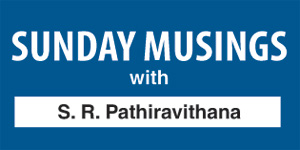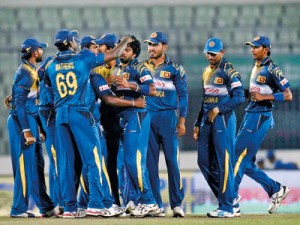Malinga: From magic to madness
View(s):Sometimes the system creates individuals who are very unique in many ways. Then the ultimate product that is captured by the public gets embedded in the people’s imagination. Then their styles or passions just remain in the eyes of the admirers, wherever they are. Lasith Malinga definitely is one such creation. Hailing from a not so fashionable southern lower middle class hamlet in Ratgama, Malinga’s influence now has filtered into the global village.
 Besides Malinga’s cricket, his mere presence had cut a niche in the entire cricketing world.
Besides Malinga’s cricket, his mere presence had cut a niche in the entire cricketing world.
Now in most international cricketing platforms, you will capture at least one individual who will be sporting the Malinga plume. One wonders if ever Malinga thought of copyrighting his hairstyle with the relevant authorities because many people have made a few dollars or more by selling Malinga-styled hair pieces in cricketing loving countries, if Sri Lanka was playing in that match or not.
So if Malinga did really take a royalty for his hair style, he may have been able to add to the millions that he has already earned through his association with the Mumbai Indians in the IPL, which for him, it appears, is bigger than national cricket.
Yet, the fact is that Malinga remains very much a Lankan icon and his primary duty is to turn up for Sri Lanka. Just as the wickets that the bowler has taken for Sri Lanka with his slingy-bowling action, controversy also has trailed his path.
Since he made his international debut against the Australians at the Marara Cricket Ground in Darwin, way-back in 2004, capturing the wickets of Darren Lehmann and Adam Gilchrist to limit the Australian first innings to 207 runs and then followed it up with another haul of 4 for 42 in the second inning, Lasith Malinga has been in the public focus.

Sri Lankan Lasith Malinga leaves a private hospital after a medical examination in the capital Colombo on April 20, 2016.
He was different in many ways. His slingy action at the delivery point came off the chest path of the head umpire and his slight physique very unlike a tear-away speed merchant who could deliver the ball at over 140kms, took the opposition by surprise.
Then when he bagged four wickets in four balls against South Africa in 2007 during an ICC World Cup match in the Caribbeans, Malinga just strode into the cricket folklore and stardom.
The turning point in Malinga’s career came in 2008. It was when Malinga was signed up by the Mumbai Indians for the inaugural Indian Premier League tournament. It was also the first time that he had a brush with the authority. He ran into a string of problems with the then SLC Interim Committee Chairman Arjuna Ranatunga. This resulted in the bowler being almost sidelined by the Lankan cricket authority.
Since then, Malinga’s relationship with the cricket authority was turbulent. At the same time as a result of his unorthodox bowling style, injuries were also a part and parcel of his career. However, with the retirement of Muttiah Muralitharan in 2010 and Chaminda Vaas earlier, Malinga came to the status of Lanka’s premier strike bowler. Then when he announced his retirement from Test cricket on April 22, 2011to prolong his career in ODI and T20 cricket, it led to a lot of debate. A section of the cricket lore kept asking where his loyalties were. They were of the view that Malinga was more interested in IPL dollars than the national cricket interests.

Malinga's last appearence for Sri Lanka was against Afghanistan in the Asia Cup Twenty20 Championship. He captured four wickets but did not turn out for the country since then after developing a knee injury - AFP Photo
At the same time with his Test retirement, the local cricket authorities downgraded his yearly contract to category ‘B’ as he was not playing the main segment — Test cricket. Malinga protested on this issue and the Lankan authority restored his contract to category ‘A’, but, the payment was not that of a category ‘A’ player.
Then following a brush with the media that drew a lot attention, the local cricket authority had to caution Malinga. But when it came to a crux, the local management supported him and did not hesitate to change the national T-20 captaincy from Dinesh Chandimal to Malinga. Under his captaincy, Sri Lanka ended up winning its second major ICC title beating India in the final at Decca, Bangladesh in 2014.
As a result of his off-handish attitude, Malinga was never the darling of the cricket authority. When the Thilanga Sumathipala administration took over the Sri Lanka Cricket, it indicated that it follows a policy of one captain for all categories.
However when it came to the selection of the T-20 captain, the then selection committee led by Kapila Wijegunawardena named a three-headed hierarchy with Malinga as the captain, Angelo Mathews as vice captain and Dinesh Chandimal the stand-by captain.
Chandimal then led the Sri Lankan team to India in the T-20 series as both Malinga and Mathews were in the injured list. Then Malinga who was in-and-out of international cricket due to the knee injury that kept bothering him since November last year was named as the national T-20 captain for the Asia Cup defence in Bangladesh and the ICC T20 title defence in India. However, after the first Asia Cup match against the UAE, Malinga was injured again.
Then understandings and misunderstandings led to a situation where the national captaincy changed from Malinga to Chandimal and to Mathews. The end result was the Lankan cricket plunging into turmoil. Yet in the midst Malinga who pulled out of his captaincy because of his injury was included in the T-20 squad and he promptly pulled out of it after the first practice session.
Thereafter a string of incidents culminated in the bowler travelling to Mumbai and seeking medical advice where they too stated that the bowler would be out of action for a given period of time. Malinga travelled to Mumbai to meet the Indian medical experts without SLC clearance. This irked the Lankan cricket authority,
Promptly the SLC summoned him home and a medical team that comprised Prof Arjuna de Silva, Dr. Harindu Wijesinghe, Dr. Tharindu Wijesinghe and Dr. Kithsiri assessed the injuries of Malinga.
It was learned that Malinga, 32, is suffering from a bone bruise which doctors say occurs as a result of sustaining forceful impacts while playing sports. In the case of a bowler like Malinga, his left knee supports his entire body weight during his delivery stride.
The full report of the medical report is due on Monday.
Commenting on the Malinga saga, SLC secretary Mohan de Silva told the Sunday Times: “Malinga is a national icon. He is held in the same pedestal as players in the calibre of Kumar Sangakkara and Mahela Jayawardena. Younger cricketers look up to the stature of players like Malinga and he should live up to it.
“Hopefully Malinga would be back on track by November. His injury is as such there are no shortcuts for his cure and it would take a lot of care and nursing for him to be well enough for action”.
De Silva also said the experts had revealed that Malinga should have not been a part of the Asia Cup tournament and even in the T-20 World Cup. He should have played only when it was really required.
He said Malinga would have been alright if he had not exerted himself playing badminton in a bid reduce his weight – that too without proper authorisation. During the last Pakistan series there were accusations of Malinga being overweight and some little known batsmen taking liberties with his deliveries in the ODI and T-20 matches.
The SLC secretary added, “Malinga has another 3-4 years of International cricket in him and we are sure that he could come back to his prime. Yes, we do have a few issues with him about his recent behaviour and we are hoping to have a chat on them”.


